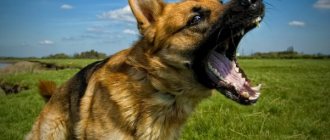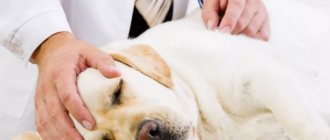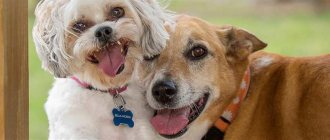You can wean your dog from running after cars using various training methods - distraction, learning stop commands, using a system of reward and punishment. Undesirable behavior is a manifestation of hunting instincts or ordinary curiosity and can occur in both puppies and adults.
Training of young animals is carried out using distraction, paying attention to the socialization of the pet. To correct the behavior of an adult dog, stop commands and punishment are used (a strict collar, a ban on favorite games). In advanced cases, they resort to the help of a dog handler.
How to stop a dog from chasing cars
You can wean a dog from running after cars based on knowledge of animal psychology, taking into account the individual physiological characteristics and temperament of the pet. Dog handlers use the following behavior correction methods:
- Distraction method . This technique is most effective for young animals. The pet's attention should be quickly transferred from an unwanted object (a moving car) to a safer one, for example, a favorite ball or toy. Involvement in play will reduce the animal's interest in machines.
- Stop command training . For this purpose, it is best to choose the command that the dog performs best, for example, “Sit.” It should be used when the animal approaches the vehicle. They start training with a long leash, then in a closed area you can make the lesson more difficult and train the dog to stop on command without a leash.
- Punishment . The method is, of course, not based on physical violence. Punishment involves the use of a “strict” collar, removal of the offending dog from its favorite games, and prolonged exposure to a static position, for example, on the command “Sit.”
The use of special shock collars is undesirable. Illiterate training using force can lead to the most unexpected and negative results.
We recommend reading about what to do if your dog is afraid to walk. From the article you will learn why a puppy or an adult dog is afraid to walk outside, and how to help your pet overcome its fear.
And here is more information about what to do if a dog jumps on people.
Puppy behavior correction
Chasing moving vehicles is typical primarily for young animals. Puppies become curious about the world around them, and a moving car arouses their active interest. Proper education will help you stop throwing yourself at cars:
- You should only walk your pet outside if you have a leash. The equipment must be selected so that the owner has the opportunity to quickly take the pet on a short leash.
- You should gradually adapt your puppy to the outdoors. At first, you can take him out for 10 minutes 3-4 times a day, while training him to use the toilet outside.
- You should cross the road with an animal on a leash only after the young animal has mastered the command “Near” and “Don’t”.
- When approaching the curb or edge of the roadway, you must stop. The dog should start moving only on the command “It’s OK” or “We’re going.” Unwanted behavior is stopped with a jerk of the leash and the command “No”.
Training sessions should be held in an area with little traffic. In order for the puppy to develop correct behavior, you should constantly cross the road only with the permissive command “It’s possible” or “Let’s go.” When the animal learns to behave impeccably, you can move on to the next stage of training, using a longer leash. Of course, correct execution of a command should be rewarded with treats and affection.
Raising an adult dog
Dangerous behavior of a pet in adulthood requires immediate correction. If the dog is on a chain or in an enclosure for a long time, and during a walk he begins to run after cars, then it is necessary to devote enough time to active exercise. You should play with the animal in a closed area, using your favorite toys, learning commands and exercises. When tired, the dog will show less interest in moving objects.
In the case when the dog began to run after cars as an adult, walks should be moved to a quiet area away from the roadway. The dog must be on a leash. When crossing the road, you need to sharply jerk the leash to stop any movements of the pet towards moving vehicles. An adult dog can also be taught the stop command by using it in front of the roadway.
The established dangerous habit of chasing cars cannot always be corrected on your own. In advanced cases, you should contact a professional dog handler for help.
Training and patience
Correct undesirable behavior using a reward system. It works much better than punishment. Analyze what your dog likes more: treats or praise. This will be her reward for good behavior.
- Go for a walk in places where you are likely to encounter moving objects - cars and bicycles - that your pet doesn't like so much. The dog must be kept on a leash! Moreover, if the length of the leash is not adjustable, take the one that is shorter.
- As soon as you feel that the animal is going to rush at the car, you need to give any prohibiting command that the pet knows: for example, “No!” or “Ugh!” It is important not to tug on the leash or tear it. Just hold and don't let the dog escape.
- After the ban comes the beckoning command “Come to me!” If the dog responds, praise it and give it a treat.
- If the pet does not pay attention, a separate study of the “prohibition-recall” pair is needed.
At the second stage, they train movement without a leash so that the free-walking dog calmly reacts to passing objects:
- You should not immediately remove the leash: the dog cannot be completely trusted yet. To control your pet, just tie a ribbon to the collar. If he disobeys the command, you can restrain him.
- The algorithm of actions is the same as in the previous stage. As soon as a car passes, the owner gives a prohibiting command and the command “Come to me!” If the pet does them, he should be praised or encouraged. If not, you'll have to go back to the leash stage.
- As soon as the dog stops making mistakes and confidently and obediently approaches you, you can remove the control tape.
The main rule: if you have little experience or your pet does not obey, you should not experiment with self-training - this can only worsen the situation.
Contact a dog trainer or animal psychologist - a specialist will find an approach specifically to your dog.
Photos:
Some dogs like to chase fast-moving objects, including vehicles. You can watch how a dog, seeing a car, prances and rushes in pursuit. You can often see stray dogs deliberately waiting for a car and then jumping out onto the roadway barking. If your ward has succumbed to such a temptation at least once, it is necessary to take measures. Let's figure out how to stop a dog from running after cars.
Car chasers very often suffer serious injuries and die under the wheels. In addition to damaging the dog’s health, you need to understand that an animal that suddenly jumps onto the road can provoke an accident in which people will be injured or killed.
You may decide to only walk your dog on a leash, but that won't solve the problem. On every walk, your pet will become overstimulated and suffer from limited willpower. After each walk, the dog will become convinced of its intentions and in the end, it will break off the leash, and you will not be able to do anything.
Note! The desire to chase after transport is a dangerous and difficult to eliminate condition. In acute situations, it is better to contact a dog handler or an experienced trainer.
Why do dogs run after cars and attack them?
There are two main reasons why dogs run after cars and rush at them - the hunting instinct and curiosity. These are the factors that underlie your pet's unsafe behavior.
A dog with well-developed hunting instincts perceives a moving vehicle as a large living object. Assuming there is danger in it, the dog chases the car, barks at it and even throws itself under the wheels. As a rule, a machine that has invaded the animal’s territory is subject to such an attack.
Curiosity is another reason why dogs attack cars. Young animals want to take a closer look at moving parts (car rims or spinning bicycle wheels) and begin to chase the vehicle.
There are situations when a dog that has lived for a long time in a village or country house, after moving to the city, begins to attack cars. This phenomenon is associated with a reaction to stimuli. Pets can acquire the habit of chasing cars and barking at them both as a puppy and as an adult. Such unsafe behavior must be corrected at the first sign, without excluding the help of an experienced dog handler.
Correction methods
How to stop a dog from running after cars? At a young age, the distraction method will help. As soon as your pet begins to show interest in cars, you need to contact him, saying his name, and offer toys.
This will distract his attention from the moving object. You can also pet your dog and offer him a treat. However, this method must be used with caution, because the animal may perceive it as encouragement.
You can also teach your pet a special stop command (for example, “Sit,” “Stand,” or “Lie down”). It should be used during walks when the dog starts barking at cars. The team must be accompanied by a jerk of the leash.
However, such behavior correction methods are applicable only to service breed dogs. Hunting dogs may not hear commands or respond to distractions during a chase. Such breeds require a special approach, which we will consider further.
[custom_ads_shortcode2]
A dog barks at cars: what to do?
If a dog barks at cars, then you can correct the behavior by switching the pet’s attention to more interesting things - an entertaining game, a favorite toy. If the dog stops barking at the car and immediately responds to the command “Come to me,” then this behavior is reinforced with a treat. The technique works if the reason for the dog’s dangerous maneuver is curiosity and boredom.
You can correct your behavior by learning the “Be Quiet” command. It is more difficult to train an adult dog, so it is important to socialize the animal during puppyhood. When barking at a dog’s car, you should lightly click on the nose or sharply pull the leash, while giving the command “Be silent.” If the dog becomes silent, reward it with a treat.
If an animal barks at passing cars while guarding the territory, then serious behavior adjustments will be needed, and it is best to contact a dog handler. Installing a high fence, fencing, or barriers will help reduce the effect of the irritating factor. However, in most cases, the dog identifies the car by ear, so such measures are not always productive.
What breeds are prone to chasing vehicles?
Many dog breeds lunge at cars and bark loudly. However, this behavior is more often observed in hunting dogs, because during the breeding process they specifically developed the skills of pursuing small prey. The following types of dogs are prone to chasing:
If you do not fight this habit, the dog can overtake and injure a small animal, for example, a cat. There have been cases of animal attacks on cyclists and joggers. Following the hunting instinct, the dog can bite a moving person on the leg.
Therefore, if a dog barks at cars and tries to run after them, then such behavior should not be encouraged. Otherwise, you will have to bear responsibility for your pet's aggression.
However, in hunting dogs this habit is difficult to correct. Long and persistent dog training is required. It is best to wean your pet off from chasing cars at a young age. The older the animal, the more difficult it is for him to change his habits.
[custom_ads_shortcode2]
How to stop a dog from jumping on a car: preventive measures
The following preventive actions will help stop your dog from jumping on the car:
- socialize your pet from a very early age;
- teach the animal commands and unquestioning obedience during walks;
- do not allow the dog to be alone for a long time;
- Walk your pet regularly, encouraging correct behavior.
We recommend reading about why dogs are afraid of people. From the article you will learn about why a puppy or an adult dog is afraid of people, what kind of people dogs are afraid of, and how to wean your pet from such behavior.
Here's more about how to play with your dog in any weather.
A dog runs after cars, barks at them, usually realizing its hunting instinct, protecting the territory or out of curiosity. Dangerous behavior should be prevented by paying attention to the socialization of the animal from puppyhood. Learning safe words, distracting the animal from the irritating factor, regular long walks, and active games will help correct the situation.
What not to do
Before answering the question of how to stop a dog from running after cars, let’s consider the wrong actions of owners in such a situation. Often, pet owners use a shock collar. It is highly undesirable to do this.
This overly strict method of training will only lead to the opposite result. Feeling pain from the electric shock, the animal may show aggression towards a moving object.
It is also wrong to ignore this pet behavior. If the owner does not react in any way to the dog’s bad habits, then the animal perceives this as encouragement. In the future, the tendency to chase and attack moving objects will only worsen.
[custom_ads_shortcode3]
Useful video
Watch this video on how to stop a dog from barking at cars:
Similar articles
- A dog jumps on people: why, how to wean off jumping...
Recommendations on how to wean a small dog from jumping: Often, household members take a small cute puppy at first... A special technique will help to wean a baby from jumping to greet you: upon entering the room, you should immediately put your bag and things on the floor and squat or kneel. Read more - The dog barks at night: why, how to wean it off, what to do...
How to stop a dog from barking at night: From puppyhood, the dog must be taught the “Quiet” command. … Experienced dog breeders and dog handlers recommend the following methods to owners of noisy pets on how to stop a dog from barking at night: From puppyhood, the dog must be taught the “Quiet” command. Read more
- How to play with a dog (at home, on the street), how to teach...
The dog will happily run after its owner. You can diversify and complicate the exercise with obstacles. ... The dog will also enjoy such homemade fun as learning to count. The same items are used for this. The dog “counts” objects - it gives a voice according to the owner’s conditioned signal... Read more
- The dog is afraid to walk: what to do if he is afraid on the street...
If a dog is afraid to go for a walk, then simply overcoming this fear will not work. First you need to establish the cause. For example, if she suddenly got scared of sharp sounds, other dogs, or is afraid to walk outside in the evening, then the approaches will be... Read more
- The dog is afraid of people: which ones, how to wean them off being afraid on the street...
How to stop a dog from being afraid of people on the street. Faced with an inadequate reaction, the owner must identify not only the cause of the strange... The owner will have to work long and patiently with the problem of how to wean a dog from being afraid of people. In a situation where a dog is running away from a “scary” object, do not... Read more
The best treatment is prevention
Have you noticed that dogs chase cars as adults? Puppies may be afraid of transport, interested in it, but do not try to chase it. The reason is that following vehicles is a habit that takes time and complete freedom of action to develop. This explains the obsession of stray animals that wait in packs for transport, chase cars and cyclists, and sometimes even manage to bite a bumper or wheel.
A pet that is walked under supervision should not, in theory, acquire such habits, but (!) it may begin to imitate other dogs. Such offenses must be nipped in the bud, very strictly and unambiguously. However, the relevance of the methods depends on the animal’s compliance and one should not go too far in this matter either.
Important! Do not let your dog off the leash, even away from the roadway, if you are not sure that the pet is under control.
The soft method is distraction. As soon as your ward becomes interested in cars, give him a nickname and distract him with a toy, stroking, or other stimulus. This method works on very young and service dogs with a clear focus on humans. Treats are also a great distraction, but be careful that your dog doesn't think you're praising him for paying attention to the car. When working with the distraction method, you must understand that the effectiveness of the correction will depend not on the dog’s abilities, but on your concentration and attention.
Note! If a dog barks at cars while guarding the yard, this is not very good, but can be considered as a variant of the norm. Please note that with this tendency, you must take care of the strength of the fence and absolutely limit the movement of the pet.
For animals that pay attention to cars while in their own yard, the distraction method is also suitable, but is it relevant for the owner? Agree, few people agree to sit on the street day and night just to observe the behavior of their ward. An alternative is toys, but not simple balls and bones, but something interactive, for example, a car stingray suspended on a cable.
Note! Replacing the fence with solid shields will not solve the problem, because the dog not only sees, but also hears the car. However, it makes sense to cover part of the fence with a thick awning so that the dog’s “post” is not too wide.
Dogs living in yards or enclosures must be walked, since one of the reasons is loneliness or low socialization. Any service breed is hardy and needs exercise, so patrolling the yard is not enough. At least every other day, walk your ward on the site with other dogs and do training.











